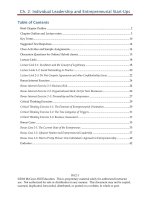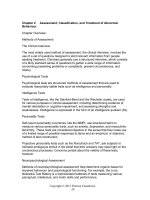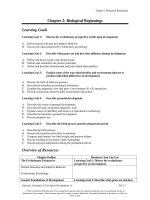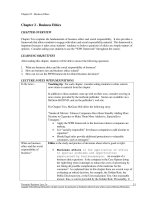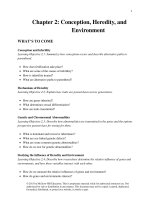Test bank and solution manual of ch02 cultural and communication (2)
Bạn đang xem bản rút gọn của tài liệu. Xem và tải ngay bản đầy đủ của tài liệu tại đây (462.24 KB, 9 trang )
Chapter 2 Culture and Communication
Chapter 2— Culture and Communication
At a Glance
Understanding Cultures and Co-Cultures
Components of Cultures and Co-Cultures
How Culture Affects Communication
Communicating with Cultural Awareness
Learning Objectives
After studying this chapter you should be able to:
1. Define culture and explain how culture is acquired.
2. Differentiate in-groups and out-groups.
3. Define co-culture and identify examples of co-cultures.
4. Differentiate the components of culture and co-culture: symbols, language, values, and
norms.
5. Contrast individualistic and collectivistic cultures.
6. Distinguish between low- and high-context cultures.
7. Differentiate low- and high-power-distance cultures.
8. Summarize how cultures vary in views about masculinity and femininity, and about men
and women’s roles.
9. Describe how cultures vary in their orientation toward time and uncertainty avoidance.
10. Describe strategies for communicating with cultural awareness.
11. List and summarize communication codes that vary across cultures.
Floyd: Communication Matters, 2e
IM-2 | 1
© 2014 by McGraw-Hill Education. This is proprietary material solely for authorized instructor use. Not authorized for sale or distribution in any
manner. This document may not be copied, scanned, duplicated, forwarded, distributed, or posted on a website, in whole or part.
Chapter 2 Culture and Communication
Lecture Outline
I. Understanding cultures and co-cultures.
A. What is culture?
1. A culture is the totality of learned, shared symbols, language, values, and
norms that distinguish one group of people from another.
2. A society is a group of people who share a common culture.
B. Distinguishing between in-groups and out-groups.
1. In-groups refer to groups with whom we identify.
2. Out-groups refer to groups we see as different from ourselves.
3. Facebook exemplifies both in-groups and out-groups.
4. Challenges of out-group status include higher stress levels, feelings of
discomfort, and potential discrimination.
C. Acquiring a culture.
1. Culture is not necessarily related to or based on our ethnicity, which is our
perception of our ancestry or heritage.
2. Culture is not necessarily related to our nationality, which is our status as a
citizen of a particular country.
3. Culture is learned. Enculturation is the process of acquiring a culture.
D. What is a co-culture?
1. Co-cultures are groups of people who share values, customs, and norms
related to mutual interests or characteristics besides their national citizenship.
2. Culture is based on many variables, including shared activities and beliefs and
mental and physical abilities.
3. Many people identify with multiple co-cultures simultaneously.
4. The Internet offers multiple opportunities for people to develop and
participate in online co-cultures.
II. Components of cultures and co-cultures.
A. Cultures vary in their symbols.
1. A symbol is something that represents an idea.
2. Each society uses symbols that carry particular meanings for its members.
B. Cultures vary in their languages.
1. Language allows for written and spoken communication.
2. Language ensures that cultures and cultural ideas are passed from one
generation to the next.
C. Cultures vary in their values.
1. Values are the standards a culture uses to judge how good, desirable, or
beautiful something is.
2. Values are cultural ideas about what ought to be.
Floyd: Communication Matters, 2e
IM-2 | 2
© 2014 by McGraw-Hill Education. This is proprietary material solely for authorized instructor use. Not authorized for sale or distribution in any
manner. This document may not be copied, scanned, duplicated, forwarded, distributed, or posted on a website, in whole or part.
Chapter 2 Culture and Communication
D. Cultures vary in their norms.
1. Norms are rules or expectations that guide people’s behavior in a culture.
2. What might be “normal” for one culture may be very different for another.
E. Co-cultures’ distinctive symbols, language, values, and norms.
1. Co-cultures frequently use jargon, or terminology that is only understood by
others in the same co-culture.
2. Co-cultures often arise precisely because their members share specific values.
III. How culture affects communication.
A. Individualistic versus collectivistic cultures.
1. In an individualistic culture, people believe that their primary responsibility
is to themselves.
2. In a collectivistic culture, people are taught that their primary responsibility
is to their families, their communities, and their employers.
3. A culture’s individualistic or collectivistic tendencies can affect how members
experience conflict and how comfortable people are with public speaking.
B. Low- versus high-context cultures.
1. In a low-context culture, people are expected to be direct and to say what
they mean.
2. In a high-context culture, people are taught to speak in a less-direct way and
to infer meaning from contextual cues such as nonverbal signals.
3. The communicative context can affect how people handle criticism and
disagreements.
4. When individuals from low- and high-context cultures communicate with
each other, there is potential for misunderstanding.
C. Low- versus high-power-distance cultures.
1. A low-power-distance culture believes that all people are equal, and that no
one person or group should have excessive power.
2. In a high-power-distance culture, certain groups (royalty, the ruling social
class) have great power, whereas the average citizen has much less.
3. Power distance affects views on friendships and romantic relationships, and
the way people think about authority.
D. Masculine versus feminine cultures.
1. A masculine culture is composed of people who cherish traditionally
masculine values such as ambition, achievement, and the acquisition of
material goods.
2. A feminine culture is composed of people who value nurturance, quality of
life, and service to others.
Floyd: Communication Matters, 2e
IM-2 | 3
© 2014 by McGraw-Hill Education. This is proprietary material solely for authorized instructor use. Not authorized for sale or distribution in any
manner. This document may not be copied, scanned, duplicated, forwarded, distributed, or posted on a website, in whole or part.
Chapter 2 Culture and Communication
E. Monochronic versus polychronic cultures.
1. A monochronic culture views time as a commodity that can be earned, saved,
spent, and wasted.
2. A polychronic culture conceives time as more holistic, fluid, and less
structured.
F. Uncertainty avoidance is the extent to which people try to avoid situations that
are unstructured, unclear, or unpredictable.
1. Uncertainty-avoidant cultures are unlikely to take risks, for fear of failure.
2. Uncertainty-accepting cultures are more open to new situations and more
accepting of people and ideas that are different from their own.
IV. Communicating with cultural awareness.
A. Be open-minded about cultural differences.
1. Be mindful of differences, which involve an awareness of how others’
behaviors and ways of thinking are different from our own.
2. Avoid ethnocentrism, the tendency to judge other cultures’ practices as
inferior to our own.
B. Be knowledgeable about different communication codes, the verbal and
nonverbal behaviors whose meanings are often understood only by people from
the same culture.
1. Cultures use different idioms whose meanings are not necessarily obvious to
people from other cultures.
2. Cultures use different jargon, or language whose technical meaning is
understood by people within a given co-culture, but not necessarily by those
outside it.
3. Cultures use different gestures, or movements, that express ideas.
C. Be flexible and respectful when interacting with others.
1. Expect ambiguity.
2. Appreciate differences in access to communication technology.
3. Adapt to others, or change your behavior to accommodate what others are
doing.
Floyd: Communication Matters, 2e
IM-2 | 4
© 2014 by McGraw-Hill Education. This is proprietary material solely for authorized instructor use. Not authorized for sale or distribution in any
manner. This document may not be copied, scanned, duplicated, forwarded, distributed, or posted on a website, in whole or part.
Chapter 2 Culture and Communication
Key Terms
Culture
Low-power-distance culture
Societies
High-power-distance culture
In-groups
Masculine culture
Out-groups
Feminine culture
Ethnicity
Monochronic
Nationality
Polychronic
Enculturation
Uncertainty avoidance
Co-cultures
Mindful
Individualistic culture
Ethnocentrism
Collectivistic culture
Communication codes
Low-context culture
Adapt
High-context culture
Floyd: Communication Matters, 2e
IM-2 | 5
© 2014 by McGraw-Hill Education. This is proprietary material solely for authorized instructor use. Not authorized for sale or distribution in any
manner. This document may not be copied, scanned, duplicated, forwarded, distributed, or posted on a website, in whole or part.
Chapter 2 Culture and Communication
Additional Lecture Ideas
1. If your college hosts a “Global Awareness Day” or “International Fair,” seize the
opportunity! Take a field trip during class time to allow your students to soak in cultures
they might not otherwise experience.
2. Invite a professional to class who has made a career in the international marketplace.
Ask students to prepare questions concerning cross-cultural challenges. Here are a few to
get you started:
Have you ever had a language barrier that seemed insurmountable? Have your words ever been “lost in
translation?”
How have you adapted to a culture’s customs to be more effective in your career?
Describe the most challenging experience you have had in a culture different from your own.
3. Invite a representative from your college’s Study Abroad program to come to class and
discuss educational travel opportunities with your students. If possible, assemble a panel
of previous student participants who can share about their own unique experiences in
cultures very different from their own.
Floyd: Communication Matters, 2e
IM-2 | 6
© 2014 by McGraw-Hill Education. This is proprietary material solely for authorized instructor use. Not authorized for sale or distribution in any
manner. This document may not be copied, scanned, duplicated, forwarded, distributed, or posted on a website, in whole or part.
Chapter 2 Culture and Communication
Classroom Discussion and Activity Topics:
1. Spend a day having your own in-class cultural fair. Have students prepare a short 1-2
minute speech of introduction on their cultural background and specific symbols,
language, values and norms. Encourage students to bring in clothing, food samples,
photographs, mementos, etc., that represent their culture. Be sure to allow time for peer
interaction after all speeches have been presented.
2. If the Olympics are taking place during the year, have the students research an Olympian
of their choice from outside the United States. Ask students to identify unique
characteristics about the chosen Olympian’s culture. This could be presented either in an
essay format or given as a speech. If utilized as a speech assignment, consider creating a
grading rubric that includes the following considerations:
•
Physical delivery style (Does the speaker make eye contact? Does the speaker smile at the audience? Does
the speaker incorporate appropriate gestures and limit unnecessary ones?)
•
Vocal delivery style (Does the speaker project his or her voice loudly? Does the speaker present at an
appropriate pace? Does the speaker avoid using vocal fillers (“ums”) and pausing excessively?)
•
Strength of content (Does the speaker spark audience interest in his or her chosen Olympian? Does the
speaker engage the audience with facts about the Olympian’s culture?)
•
Organization of content (Is the speech of introduction easy for the audience to follow? Does the speaker
remember to express pleasure in introducing the chosen athlete, and does the speaker build suspense when
introducing the Olympian?)
•
Visual aids and props (Are props, costumes, photographs, etc. used to enhance the presentation?)
•
Overall effectiveness (Overall, does the speaker execute the speech in a professional, well-rehearsed,
manner? Does the speaker refrain from distractive behaviors such as dressing unsuitably, chewing gum, using
inappropriate language, etc.?)
3. In small groups, have students exchange answers to the “Sharpen Your Skills” question
presented in Chapter 2. Ask students to select the best story from the small group to share
with the larger class.
Describe an interaction you have had with someone whose language, values, or traditions differed markedly
from your own. What communication challenges did each one of you face? How did you manage those
challenges? How might you have managed them more effectively?
4. The Dark Side of Communication—Cultural Intolerance: Discrimination against Muslim
Students on U.S. College Campuses. For homework, assign students the article presented
in the Chapter 2 Dark Side of Communication, which may be found at
/>In class, ask students their opinions and perspectives on the article, and regarding
discrimination in general.
Floyd: Communication Matters, 2e
IM-2 | 7
© 2014 by McGraw-Hill Education. This is proprietary material solely for authorized instructor use. Not authorized for sale or distribution in any
manner. This document may not be copied, scanned, duplicated, forwarded, distributed, or posted on a website, in whole or part.
Chapter 2 Culture and Communication
5. Divide the class into six teams, and assign each team one of the six major cultural
differences that influence how people communicate with each other
(individualism/collectivism, communicative context, power distance, masculinity and
femininity, orientation toward time and uncertainty avoidance). As a research project,
have each group define the cultural characteristic, and then provide a country and
example that represents each side. If you have access to computers, this may be done as
an in-class assignment; it may also be used as a more formal group project and
presentation.
6. Have students complete the ethnocentrism survey, and ask your class the follow-up
questions provided in the chapter:
Were your surprised by your score? Why or why not? What factors do you think your score reflects?
How can learning about cultural influences on communication affect tendency toward ethnocentrism?
Based on your results, do you have any goals for yourself concerning cultural understanding?
Floyd: Communication Matters, 2e
IM-2 | 8
© 2014 by McGraw-Hill Education. This is proprietary material solely for authorized instructor use. Not authorized for sale or distribution in any
manner. This document may not be copied, scanned, duplicated, forwarded, distributed, or posted on a website, in whole or part.
Chapter 2 Culture and Communication
Additional Reading and Websites
The World Factbook: />The World Factbook provides information on the history, people, government, economy,
geography, communications, transportation, military, and transnational issues for 266
world entities. Our Reference tab includes: maps of the major world regions, as well as
Flags of the World, a Physical Map of the World, a Political Map of the World, and a
Standard Time Zones of the World map.
Foundation for Endangered Languages: />The Foundation for Endangered Languages supports, enables and assists the
documentation, protection and promotion of endangered languages. This website
describes activities, and includes the newsletter Ogmios and details of their conferences.
Pew Internet and American Life Project:
The Pew Internet & American Life Project is one of seven projects that make up the Pew
Research Center, a nonpartisan, nonprofit "fact tank" that provides information on the
issues, attitudes and trends shaping America and the world. The Project produces reports
exploring the impact of the internet on families, communities, work and home, daily life,
education, health care, and civic and political life. The Project aims to be an authoritative
source on the evolution of the Internet through surveys that examine how Americans use
the Internet and how their activities affect their lives.
StudyAbroad.com is the Internet's leading source of information on educational
opportunities for students to study in other countries. It is a comprehensive directory of
study abroad programs, including summer study abroad, internship, service learning and
volunteer abroad programs, high school study abroad, intensive language programs, and
more, all organized by subject or country or city. International education support through
the study abroad handbook provides a guide to education abroad, health and safety and
study abroad scholarship/financial aid information.
Pease, A., & Pease, B. (2004). The definitive book of body language: The secret meaning behind
people’s gestures. London: Orion Books.
Floyd: Communication Matters, 2e
IM-2 | 9
© 2014 by McGraw-Hill Education. This is proprietary material solely for authorized instructor use. Not authorized for sale or distribution in any
manner. This document may not be copied, scanned, duplicated, forwarded, distributed, or posted on a website, in whole or part.

